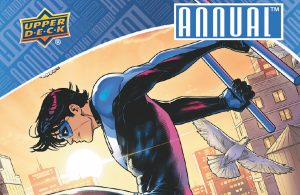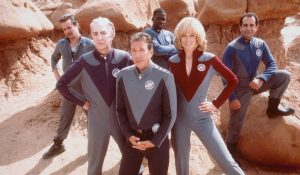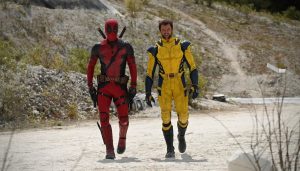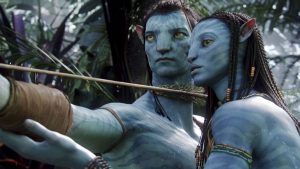
When the credits rolled on Star Trek Generations back in November 1994, some fans (including this writer) breathed a sigh of relief. While we respected William Shatner and his central role in making Star Trek happen, we also felt his time had passed. After Generations, we could finally move on from an aging The Original Series cast and focus on the continuing film adventures of Captain Picard and The Next Generation.
But there were also of course some fans (including one named William Shatner) who weren’t too happy. After all, James T. Kirk had died after falling from a rusty bridge, the franchise cutting his time too short, so that a cerebral Brit who didn’t even have the good sense to cover his bald head with a piece could lead the franchise going forward.
Shatner, of course, did what any fan does when they don’t like a creative decision: he wrote fan-fiction. And because he’s William Shatner, his fan-fiction was published as a series of official Star Trek novels. And thus, the Shatnerverse was born.
Enter the Shatnerverse
The Shatnerverse is the unofficial title for the 10 Star Trek books written by William Shatner and co-authors Judith Reeves-Stevens and Garfield Reeves-Stevens. These books pick up after Kirk’s death in Generations, bringing him back to life to interact with 24th century characters and mainstays, including the Enterprise-E and the Borg. Along the way, Kirk meets back up with his old friend Spock and even deals with a threat from the Mirror Universe.
Before we go any further, we must get this out of the way: the Shatnerverse books are indeed very goofy and self-indulgent. Over the years, Trek fans have certainly heard stories of Shatner’s inflated ego, from his tendency to steal lines from other actors during the TOS days to his insistence on having major creative control on projects, even after the debacle that was his directorial debut in Star Trek V: The Final Frontier.
But we also have to acknowledge that, just like his unique cadence, Shatner’s bluster is part of his charm. It’s exactly what makes James Kirk so fun to watch. Whatever we feel about Shatner the man, every time Kirk gets that sparkle in his eyes, we can’t help but follow him again. As veteran Trek novelists, the Reeves-Stevenses thankfully know how to keep Kirk on the right side of charming, even as they incorporate Shatner’s more indulgent ideas.
Beyond the Five Year Mission
The first trilogy of Shatnerverse books, released between 1995 and ’97, represent the best of the bunch. Ashes of Eden, The Return, and Avenger tell a rip-roaring adventure in which Kirk teams up with a hot Romulan/Klingon, defeats the Borg, and uncovers the conspiracy that made the assassination of Spock’s father look like death by disease. The first trilogy also focuses on Chal, home of the Chalchaj’qmey (Children of Heaven), a peaceful group of genetically modified Romulan/Klingon hybrids that the Klingon Empire and Romulan Star Empire designed in preparation for war against the Federation.
In Ashes of Eden, set during the late TOS era, beautiful Chalchaj’qmey Teilani recruits Kirk and Scotty on a non-Federation approved mission to save Chal from those who threaten it, including a Starfleet Admiral doing what all Starfleet Admirals do and being awful. The Return begins right after Generations, with Kirk being resurrected by the Borg and Romulans to fight against Picard. And in Avenger, Kirk reunites with Spock to investigate the connection between Chal and the death of Spock’s father Sarek.
Most agree that the second trilogy falls short of the first, but there’s fun to be had for those who enjoy the Mirror Universe. The Mirror Universe Trilogy—Spectre, Dark Victory, and Preserver—pits Kirk and Picard against the Terran Empire’s former Emperor Tiberius, none other than the evil James T. Kirk himself. The novels play as a fun continuation of “Mirror, Mirror,” the TOS episode that introduced the concept, while featuring some fun twists, including Mirror Universe Janeway and a continuation of the Klingon/Cardassian alliance from Deep Space Nine.
The Mirror Universe Trilogy works because it remains rooted in an established TOS concept, so any of the DS9 and Voyager connections feel earned. The same cannot be said of the Captain Trilogy. Captain’s Peril, Captain’s Blood, and Captain’s Glory all feel like desperate cliff notes added to the 1990s Trek series, shoehorning Kirk into places and stories where he does not belong. Captain’s Peril puts Kirk and Picard at the end of the Dominion War. Captain’s Blood sends Kirk to Remus, caught in the Romulan civil war during Star Trek: Nemesis. In Captain’s Glory, Kirk joins Admiral Janeway and the Doctor on a mission that puts them against Picard’s Enterprise and Riker on the Titan.
Following the mistakes of the Captain Trilogy, Shatner ended his run as a Star Trek author on more solid ground. 2007’s Academy: Collision Course goes back to Kirk’s first days entering the Starfleet Academy, where he meets an irritating young Vulcan called Spock. While not as audacious as the previous Shatnerverse entries, Collision Course still has the same verve from Shatner and solid storytelling chops from the Reeves-Stevens team to make for a fun read.
No Such Thing As Too Bold
As you might suspect, Shatner turns Kirk into his ultimate hero fantasy, the captain who can do anything that other Starfleet captains can do but better. He makes out with Teilani, he beats up Picard while brainwashed by the Romulans and Borg, and then beats the Borg. He discovers the truth behind Sarek’s death, a fact that eluded even Picard, who mind-melded with Sarek in an all-timer TNG episode.
And yet, it’s impossible not to be at least a little charmed by this wild take on the further adventures of James T. Kirk. Shatner and the Reeves-Stevenses keep things feeling light and fun, injecting the franchise with a burst of bold energy it sometimes lacks elsewhere.
Shatner set out to make his own universe as a corrective to the end of Generations. And it’s clear that he succeeded. Young TNG fans such as myself may have resented Shatner’s arrogance and the unending importance of Kirk, but the Shatnerverse novels remind readers of something that the character and creator brought to the universe: a sense of goofy fun.
The post The Star Trek Shatnerverse Still Features Wildest Version of Captain Kirk Ever appeared first on Den of Geek.






